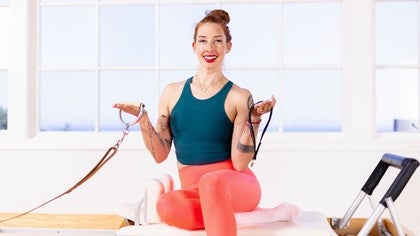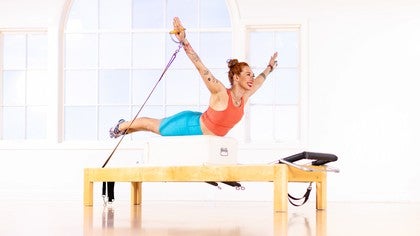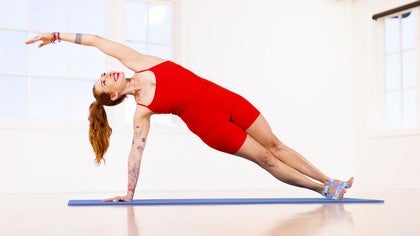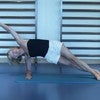Description
If you want to use these tips in a full class, try Lesley's Arm and Back Connection.
About This Video
Transcript
Read Full Transcript
Hi. I'm Lesa Logan. Today, I wanna talk about how to see if someone actually has their arms connected to the back. What are we looking for? What are some signs that they're not connected? So first one I wanna talk about is the ribs. This actually might seem a little weird why we're talking about the ribs. But if you feel like someone looks like a roasted chicken.
You know, they're at the grocery store, the roasted chickens, the ribs are out nice and wide. Telling someone to connect their upper abs or telling them to pull their lower ribs down is actually not necessarily going to fix the issue. The issue is coming from somewhere else. It's actually coming from their arms being connected to the back. If they're actually connected to the back, then we actually have access to these muscles.
And so when you are seeing that disconnection there, take a little note. We need to do some rmback connecting exercises. Those exercises could be a variety of things I won't go too much into detail with that, but you can think about, like, I'm wanting this to be down. I need to get their arms connected to their So then you can look at different things to see if they are and then teach them the connections that you're wanting. So what is that sign that you can look for that's next? So I am going you'll hear me all the time say pinky side of the hand into the handle.
And that looks like this when you're doing rowing 3, or the 100. We have a straight, not locked elbow, a straight wrist, and then the pinky side of the hand on the handle. This is actually a really tricky position for a lot of people to do. Most people will look like this. They'll be doing something and they hook the handle into the thumb, and then they're doing all the exercises like that. If they're using a loop for a handle, it's even harder.
There's not anything for the hand the pinky side of the hand to go on to a handle. And so if you don't have a handle and pinky side of the hand cannot go onto a handle, what I'm also looking for is Well, what's the hand doing? So is the hand doing the 100? Is it facing down? Like, literally if I put it all the way to the mat, would it be straight on the mat. Or if I were to take it all the way down, did it turn in or a turn out? So that will help you, like, get your mind's eye on that hand. Is it going to go all the way down.
If it looks like this, then obviously you can say pinky side of the hand onto the handle, or you can tell people if they're using the loop to, you know, turn their hand down. If those things don't work, if the actual words don't work, it's It's less that they didn't listen to you. You don't have to keep repeating to yourself. It's just, again, a sign that we have a connection we need to make. When we are doing things like teaser, the palm is up. The pinky side of the hand is into the handle up. If you don't have a handle when you're using the loop, obviously, we wanna look like we're holding a bowl.
We have a bowl of soup at all times. We would fill it. If you look like you're gonna spill that soup, that's a sign we lost that connection. So hands are either flat or all the way down, or in some exercises, they are perpendicular to the floor like an hug. Shave and hug, it's actually perpendicular to the floor. A lot of people do their hugs like this, and we're pulling. And, yes, the act the action will happen, but it's gonna get into the elbow.
It's gonna get into the biceps. It's gonna get here and not from here. Right? So again, if you're using a loop, here, it's so tempting to have that hand out here. So look for that hand being perpendicular to the floor, and that is gonna be a good sign that we have access. We have an opportunity to connect to the back. It doesn't mean it's a guarantee We have an opportunity. If the hands are not doing those things, it's it's your sign. Like, oh, we've lost that connection. So what exercises could we go to that are going to teach that connection.
Right? Like, that's gonna be something where you get to get curious and you get to create your classes around teaching those connections. What are the what are the actions that we need there? Couple other setups I wanna go through that can keep you from having access to that connection or be assigned that you've lost it. If you hear, that someone is feeling it in their wrists or even feeling it in the front of their shoulder, pain, We shouldn't have pain in Pilates. Right? It is it definitely should feel hard and challenging, but not painful. And so when you're setting things up on the when you're saying your hands up on the equipment, putting your hands on the foot bar, it's really difficult with wider foot bars.
And I know every reformer has a different width of a footbar, but the wider the footbar, the harder it's going to be. So you might need to use, like, a thayer band or a sticky pad to put on the foot bar to give yourself something to grip, you want the wrist to be as straight as possible. So long stretch my hands are gonna be here on this front part of the foot bar. A lot of people will set up down here. This is gonna keep me. It's just it's It's just the way the body works, loves. It's just gonna keep me from having this access.
Could I get it? Yes. We all do push ups, but is it harder Absolutely. So if we can set people up at that front with a straighter wrist, that's gonna be helpful. Also pulling the foot bar apart when people lock their elbows out, it's an immediate disconnection of the muscles below and above. Right? So softening the elbows is something easy to say, but it doesn't always mean that we're gonna get the connection we want. So what I love to do is pull that foot bar apart you really can't lock the elbows when you do that, and it's actually gonna help you feel like you've been pulling from back here, give you the connection that you need.
If you are doing long back stretch, the hands or tendon stretch, the hands come to this side. Again, that straight wrist is what we're looking for. If all we can do is hold the exercise in that position, I'd rather that than slide the hands into a position that they feel locked in and then doing the choreography. Building up the strength, building up the connection, building up the hold is going to be the, the, the best way to build those foundations, and it's gonna act, open up access to so many more exercises sooner. When people say they fill things in their risk, the reason is not just that they've disconnected from The wrist actually doesn't have the muscles. And that's not where your your strength is coming from.
It's coming from here and here. So we actually have to be connected here, and then we do need that forearm strength to keep us out of here. But if you're not connected here, I don't care how strong your forearms are. Good luck. When you are using your shoulder rest, the same rules apply. You wanna be all the way back here with those straight wrists. And, yes, that can feel a little scary. I remember my first time doing the control push ups. I was like, are you kidding? I'm gonna slide off.
So what you really wanna do is actually almost feel like you could create a fist around your shoulder blocks where I push my fingertips into the block. That's gonna activate those forms. And then because my wrists are straight, I'm gonna access to my arm back connection. If you go here, it's actually not gonna feel very fun, and you're gonna you're going to have to push from your chest. Same thing with the control push ups here. Look for that straight wrist.
Set yourself up for success. Grab a sticky pad if it's still really scary. Come on. Hold it for a second and come right back off. There is no shame in building up that strength game, right? Like, taking your time to really get comfortable And what happens is the more often you do it, the less scary it is. Another place to focus on the risk being straight is when you actually hold your box, your short box poll.
So when people have the box poll, what tends to happen is they let their wrist hang. Right? And it's like, and so that little bright that little bin right there actually keeps you from having access to all this amazing stuff. So pulling the bar apart is gonna be helpful. Pressing the pinky side of the hand into the bar is helpful. And also something I love to think about is, like, bending the bar, like, making it like a if I could make it round. I can't. But then it's probably a good thing, but doing that.
Another thing is if your bars are really short, that is going to require somebody to have ton of flexibility in their shoulder, it is you're asking them to have an advanced arm back connection. So if the bars are short holding it wide on the sides like this is actually going to allow you to give them that connection and then or just get a longer bar. Right? And then when you have a bar where your hands like this, have them pull out just like we did on the foot bar, that's going to really widen their upper back. And finally, another sign that your clients, yourself, the people you teach classes have lost that arm back connection or don't have it yet, is that you're consistently saying shoulders down. The thing is is that when we repeat ourselves, it feels helpful. We're finding something that they need more of, and we're giving them that cue.
And so I totally get it. I really do. The problem with that is is that repeating yourself, oftentimes allows our clients to tune out because they're they're like, I did that already. And so if you're saying shoulder's down and they think they did it and you didn't see that connection, it's not that they didn't listen to you. It's not that they don't hear you or didn't didn't wanna do it, it's that they don't have the connection yet. And so that's where you get to be curious. Okay. We don't have the Endurance to keep that connection.
They had it rep and they lost it, or they just haven't made the strength there. So again, finding exercises that can teach that connection that can build that up And what will happen is you can actually refer back to that exercise where they felt that connection instead of repeating shoulders down. So set yourself up for success, straight wrist, working that upper back wide. And then if you still need more, go to the exercise that are gonna that strength up, come back to those exercises, and then challenge yourself. See, did your hand stay without being told what to do? Did your pinky hand stay on the handle or were you able to keep your hand perpendicular in your hug, or were you able to reach your pinky side of the hand up and teaser? Those are gonna be cues that you are getting the connections and you're keeping them and that's gonna be something fun to celebrate.
Thank you so much. I hope this was really helpful. Enjoy finding your arm back connection.
Making Connections: Arm & Back Connections
Comments
You need to be a subscriber to post a comment.
Please Log In or Create an Account to start your free trial.



















